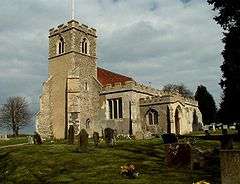Acton, Suffolk
| Acton | |
 All Saints church, Acton |
|
 Acton |
|
| Population | 1,811 (2011)[1] |
|---|---|
| OS grid reference | TL893449 |
| District | Babergh |
| Shire county | Suffolk |
| Region | East |
| Country | England |
| Sovereign state | United Kingdom |
| Post town | SUDBURY |
| Postcode district | CO10 |
| Dialling code | 01787 |
| Police | Suffolk |
| Fire | Suffolk |
| Ambulance | East of England |
| EU Parliament | East of England |
| UK Parliament | South Suffolk |
Coordinates: 52°04′15″N 0°45′40″E / 52.07071°N 0.76102°E
Acton is a village and civil parish in the English county of Suffolk. The parish also includes the hamlets of Cuckoo Tye and Newman's Green.
Etymology
According to Eilert Ekwall the meaning of the name is Village by the Oaks.
History
The Domesday Book records the population of Acton in 1086 to be 83. All Saints is the local church. There are five bells that hang in the church with the heaviest weighing 8-1-4 cwt [2]
Newman's Green
Newman's Green is a hamlet in the parish of Acton, in the Babergh District, in the county of Suffolk. Nearby settlements include the town of Sudbury and the villages of Acton, Great Waldingfield, Long Melford and the hamlet of Cuckoo Tye.[3]
Industry
Between 2001 and 2002 the Reliant Robin was produced in the village's industrial estate.
Notable former residents
William Jennens was known as "William the Miser" and the "Acton Miser." Jennens made his money loaning money to gamblers and was Britain's richest man at the time of his death in 1798, but aged 97 he had outlived the nominated executors and beneficiaries under his will. According to the BBC QI series, Jennens vs Jennens commenced in 1798 and was abandoned in 1915 (117 years later) when the legal fees had exhausted the Jennens estate of funds (worth c. £2 million).[4][5] The case of Jennens v Jennens formed part of the inspiration for the Jarndyce and Jarndyce case at the centre of the plot of Bleak House by Charles Dickens.[6]
Another Acton resident, Catherine Foster, was believed to be the last woman to be hanged at Bury St Edmunds, in 1847. At the age of 17 she poisoned her husband by putting arsenic in his dumplings. The propriety of this case was discussed in the House of Lords and reported in Hansard.[7]
Population change
| Population growth in Acton from 1801 to 1891 | ||||||||||
|---|---|---|---|---|---|---|---|---|---|---|
| Year | 1801 | 1811 | 1821 | 1831 | 1841 | 1851 | 1881 | 1891 | ||
| Population | 461 | 470 | 555 | 565 | 555 | 539 | 579 | 619 | ||
| Source: A Vision of Britain Through Time[8] | ||||||||||
| Population growth in Acton from 1901 to 2011 | ||||||||||
|---|---|---|---|---|---|---|---|---|---|---|
| Year | 1901 | 1911 | 1921 | 1931 | 1951 | 1961 | 2001 | 2011 | ||
| Population | 593 | 541 | 447 | 496 | 673 | 603 | 1,800 | 1,811 | ||
| Source: A Vision of Britain Through Time[8] | ||||||||||
References
- ↑ "Parish population 2011". Retrieved 13 September 2015.
- ↑ Dove's Guide, Retrieved 2012-03-21.
- ↑ pagemost.com
- ↑ BBC QI 8 Dec 2012, Series J, Episode 12 - Justice
- ↑ The Guidott / Guidotti family, Acton Place, Summary of William Jennens
- ↑ "All Saints, Acton". www.suffolkchurches.co.uk. Retrieved 2008-10-15.
- ↑ HANSARD 1803–2005, 1840s, 1847, April 1847, 23 April 1847, Lords Sitting. THE EXECUTION OF CATHERINE FOSTER. (HL Deb 23 April 1847 vol 91 cc1240-1)
- 1 2 "A Vision of Britain Through Time". University of Portsmouth & others. Retrieved 2011-02-22.
External links
-
 Media related to Acton, Suffolk at Wikimedia Commons
Media related to Acton, Suffolk at Wikimedia Commons - Acton in the Domesday Book